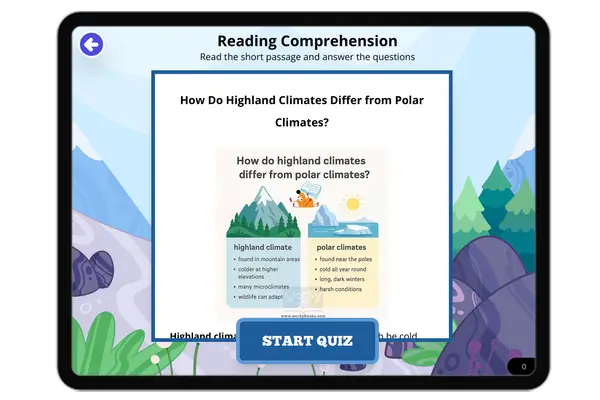Which Factor Controls the Water Cycle? — Passage
The water cycle is the continuous movement of water through Earth’s atmosphere, land, and oceans. This cycle includes key processes like evaporation, condensation, precipitation, and collection. The main factor that controls the water cycle is the Sun. Without the Sun’s energy, the water cycle would not happen. The Sun drives the movement of water by heating up Earth’s surface, especially oceans, lakes, and rivers.
When the Sun warms water, it causes evaporation—the process of liquid water turning into water vapor. This vapor rises into the atmosphere. Plants also release water vapor through a process called transpiration. Together, evaporation and transpiration add moisture to the air. As water vapor rises and cools, it undergoes condensation and forms clouds. When these clouds become heavy with water droplets, precipitation occurs as rain, snow, sleet, or hail.
The Sun not only powers evaporation but also helps shape weather patterns. It affects wind, temperature, and the movement of air masses, all of which influence how and where precipitation falls. For example, in warmer climates, more sunlight leads to higher evaporation rates, which often means more rainfall.
Real-world examples show the Sun’s power in action. In tropical areas, the intense sunlight causes rapid evaporation, leading to frequent rainstorms. In contrast, deserts receive lots of sunlight but little moisture to evaporate, so they remain dry. Even seasonal changes in sunlight affect the water cycle, such as spring snowmelt that leads to increased river flow.
Understanding how the Sun controls the water cycle helps scientists predict weather, manage water resources, and study climate change. The Sun is essential to life on Earth, and its role in the water cycle is one of the most important ways it supports ecosystems around the planet.
Fun Fact: The Sun releases more energy in one second than humans have used in all of history!
What is the main factor that controls the water cycle?
The MoonThe WindThe SunThe CloudsWhat process changes liquid water into water vapor?
PrecipitationEvaporationCondensationCollectionWhat happens when water vapor cools in the atmosphere?
It turns into snowIt disappearsIt forms cloudsIt sinks to the groundWhat is the term for plants releasing water vapor?
TranspirationCondensationEvaporationPrecipitationHow does the Sun affect rainfall in tropical areas?
It stops all precipitationIt reduces wind patternsIt increases evaporationIt cools the oceanWhy are deserts dry despite a lot of sunlight?
Too many treesLack of cloudsNot enough moistureCold windsWhat is the main idea of the passage?
The Sun creates windWater flows into riversThe Sun drives the water cyclePlants help clean the airIf there were no sunlight, what would happen to the water cycle?
It would speed upIt would stopIt would turn into snowIt would grow plants faster








